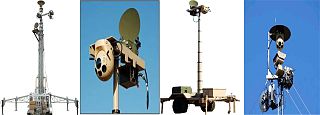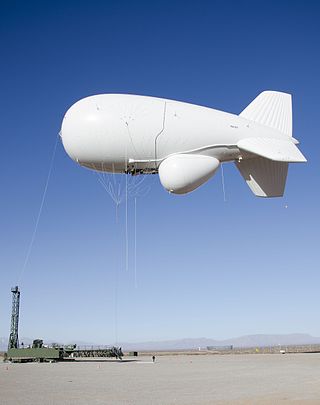Related Research Articles

ISTAR stands for intelligence, surveillance, target acquisition, and reconnaissance. In its macroscopic sense, ISTAR is a practice that links several battlefield functions together to assist a combat force in employing its sensors and managing the information they gather.
The Rapid Equipping Force (REF) was a United States Army organization headquartered in Fort Belvoir, Virginia. The organization was charged with quickly providing Army units deployed globally with innovative government off-the-shelf and commercially available solutions that address urgent requirements within 180 days or less. The REF was able to do this through unique authorities and by maintaining a presence near the point of need. REF personnel were positioned in Iraq, Afghanistan, and Kuwait and mobile laboratories are available for quick solutions. Additionally, the REF empowered the Army at a grassroots level, enabling individual soldiers to communicate needs directly through simple request forms.

Aeronautics Ltd. is an Israeli company specializing in the manufacturing of Unmanned Aerial Systems for military uses. Since its establishment in 1997, the company has sold its products to more than 20 defense, military and homeland security customers in 15 countries. Its headquarters are in Yavne, Israel.

A tethered, moored or captiveballoon is a balloon that is restrained by one or more tethers attached to the ground and so it cannot float freely. The base of the tether is wound around the drum of a winch, which may be fixed or mounted on a vehicle, and is used to raise and lower the balloon.

The Tethered Aerostat Radar System (TARS) is an American low-level airborne ground surveillance system that uses aerostats as radar platforms.

The unattended ground sensor (UGS) is under development as part of the United States Army's Future Combat Systems Program. For information on currently fielded UGS systems, refer to the Current Force UGS Program or CF UGS.
The Skystar 300 is a surveillance blimp. It is an ISR system that provides surveillance capabilities accomplished by simple equipment, which requires minimal operating skills and maintenance procedures. The system is composed of the Aerostat Balloon, filled with helium gas, dual sensor payload, control unit and the data link between the control unit and the balloon.
The ARGUS-IS, or the Autonomous Real-Time Ground Ubiquitous Surveillance Imaging System, is a Defense Advanced Research Projects Agency (DARPA) project contracted to BAE Systems.
Gorgon Stare is a video capture technology developed by the United States military. It is a spherical array of nine cameras attached to an aerial drone. The US Air Force calls it "wide-area surveillance sensor system".
The Blue Devil blimp was a proposed reconnaissance airship that was built for the United States Air Force for use in the War in Afghanistan. It was designed to capture and process data from onboard sensors before delivering it to ground troops.
Constant Hawk is a United States Army wide-area motion imagery system flown on crewed reconnaissance aircraft in Iraq and Afghanistan.

Counter-IED equipment are created primarily for military and law enforcement. They are used for standoff detection of explosives and explosive precursor components and defeating the Improvised Explosive Devices (IEDs) devices themselves as part of a broader counter-terrorism, counter-insurgency, or law enforcement effort.

The Ground-Based Operational Surveillance System, G-BOSS, created by Raytheon Integrated Defense Systems, is a trailer-mounted tower with mounted surveillance systems and integrated with the command operations center (COC) used primarily by the United States Marine Corps during operations in the Global War on Terror. The G-BOSS is used primarily for force protection, checkpoint security, route reconnaissance, patrol over watch, improvised explosive devices emplacement detection, intelligence gathering, and personnel/vehicle identification.

RT Aerostats Systems is an Israeli company that designs and manufactures the SkyStar family of aerostats, for use in intelligence, surveillance, reconnaissance and communications applications.

The Joint Land Attack Cruise Missile Defense Elevated Netted Sensor System, or JLENS, was a tethered aerial detection system designed to track boats, ground vehicles, cruise missiles, manned and unmanned aircraft, and other threats. The system had four primary components: two tethered aerostats which utilized a helium/air mix, armored mooring stations, sophisticated radars, and a processing station designed to communicate with anti-missile and other ground and airborne systems. Each system was referred to as an "orbit", and two orbits were built. The Army-led joint program which fielded JLENS was designed to complement fixed-wing surveillance aircraft, saving money on crew, fuel, maintenance and other costs, and give military commanders advance warning to make decisions and provide notifications. Following cost overruns, underperformance, declining support in Congress, and public scrutiny following a snapped tether which allowed one craft moored at Aberdeen Proving Ground, Maryland to drift on a 100-mile uncontrolled descent across Pennsylvania, dragging its cable tether which damaged power lines and cut power to 20,000 homes, the program was suspended in October 2015, and completely discontinued by 2017.
Sentient Vision Systems is an Australian company headquartered in Port Melbourne, that produces automated object detection solutions for video from aircraft and surface sensors used for intelligence, surveillance and reconnaissance (ISR), search and rescue, and law enforcement. Sentient's solutions use computer vision software to detect and track objects of interest in full motion video (FMV), both electro-optic (EO) and infrared (IR) for land and maritime environments. Sentient Vision Systems is a private company.
Wide-area motion imagery (WAMI) is an approach to surveillance, reconnaissance, and intelligence-gathering that employs specialized software and a powerful camera system—usually airborne, and for extended periods of time—to detect and track hundreds of people and vehicles moving out in the open, over a city-sized area, kilometers in diameter. For this reason, WAMI is sometimes referred to as wide-area persistent surveillance (WAPS) or wide-area airborne surveillance (WAAS).
RedKite is a lightweight, airborne wide-area motion imagery (WAMI) sensor developed by Logos Technologies, a defense contractor based in Fairfax, Virginia. The system is designed for force protection, border security, disaster response and other missions. Weighing less than 35 pounds, RedKite is equipped with a 50-plus megapixel electro-optical camera and an onboard, eight-hour data processing/storage unit. This allows users to both image a city-sized area as well as conduct analyses of live and recorded imagery in the air, in real time.
The Buckeye system is an operational airborne surveying system that provides high-resolution spatial imagery over an area of interest to support military operations involved with intelligence, surveillance, and reconnaissance. Once mounted on a helicopter or an unmanned aerial vehicle (UAV), it incorporates visual information from a digital camera and elevation data from a Light Detection and Ranging (LIDAR) system to create a two and three-dimensional colored map with orthorectified, 4 to 6-inch resolution.
Unattended Transient Acoustic MASINT Sensor (UTAMS)Mortar, Rocket, Explosive Locator System is an acoustic localization sensor system developed by the Sensors and Electronic Devices Directorate (SEDD) of the U.S. Army Research Laboratory (ARL) in 2004. This technology is utilized to detect and isolate transient events such as mortar or rocket firings, munition impacts, and other explosive events. It consists of an array of acoustic sensor stations that are linked via radio to a receiving base. Each sensor has the ability to monitor hostile territory, international borders, and/or detect indirect weapon fire covertly with 24-hour surveillance. These small, inexpensive, non-imaging sensors can monitor large areas without a significant need for power sources and manpower.
References
- 1 2 3 4 Bacon, Lance. "System gives troops 360-degree eye in the sky". Army Times. Retrieved 15 May 2012.
- 1 2 Boland, Rita. "Day/Night ISR Floats Over Afghanistan". SIGNAL Magazine. Archived from the original on 23 February 2013. Retrieved 15 May 2012.
- ↑ Buxbaum, Peter. "The Eyes Have It". Tactical ISR Technology. Archived from the original on 4 March 2016. Retrieved 8 June 2012.
- ↑ Harrison, Jay. "Where did Constant Hawk come from?". Edgefighter. Retrieved 8 June 2012.
- ↑ "Walking Back the Cat: The US Army's Constant Hawk". Defense Industry Daily. Retrieved 16 May 2012.
- 1 2 3 Iannotta, Ben (1 April 2012). "Aerostats to get wide-area night vision". C4ISR Journal: 12.
- ↑ "Logos Technologies Wide-Area Sensors Make First-Time Showing at IDEX" Logos Technologies. 6 February 2017. Retrieved 5 February 2019.
- ↑ Fein, Geoff. "AUSA 2018: US Army to begin testing of upgraded Kestrel sensor" Jane's International Defence Review. 10 October 2018. Retrieved 5 February 2019.
- 1 2 3 4 Sternstein, Aliya. "DHS Eyes Military Blimp to Stop Illegal Border Traffic". Nextgov. Retrieved 15 May 2012.
- ↑ Fein, Geoff. "AUSA 2018: US Army to begin testing of upgraded Kestrel sensor" Jane's International Defence Review. 10 October 2018. Retrieved 5 February 2019.
- ↑ "Logos Technologies Wide-Area Sensors Make First-Time Showing at IDEX" Logos Technologies. 6 February 2017. Retrieved 5 February 2019.
- ↑ Ackerman, Spencer. "DHS Uses Wartime Mega-Camera to Watch Border". Wired. Retrieved 15 May 2012.
- 1 2 Doan, Claire (6 March 2012). "Cutting-edge surveillance system strapped to Nogales blimp". KGUN-9 TV. Archived from the original on 11 June 2012. Retrieved 8 June 2012.
- ↑ "The All-Seeing Eye That Watches an Entire City at Once". Popular Mechanics. 2016-01-12. Retrieved 2016-02-05.
- ↑ Dellinger, A.J. "The privacy issue at the Olympics no one is talking about" The Daily Dot. 6 August 2016. Retrieved 5 February 2019.